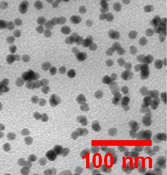
Nanoinfusion processing, backed by five patents, consists of three simple steps.
- A mild vacuum is applied to a thermoplastic polymer, which may be in the form of particles, pellets, film, or small objects to 4.8mm (0.1875") thickness.
- An organometallic or metal halide precursor is admitted to the vacuum chamber; by releasing the vacuum, the precursors readily diffuse into the polymer molecular free volume.
- Thermal, photochemical, or chemical conversion is used to convert the infused thermoplastic to a thermoplastic nanocomposite, with nanoparticles typically ranging from 2-10 nm in diameter and up to 10%/wt nanoparticle loading.
The result, is the first in-situ nanocomposite, with 100% dispersion and the capability to produce mono-sized nanoparticles. Dr. Stan Prybyla, President of Applied Nanoinfusion, commented that the technology works with virtually all thermoplastics, including numerous high performance thermoplastics. The nanoparticles can consist of metals, metal compounds, or semiconductor quantum dots. A currently available nanoinfusion system has produced up to 10 kg (22 lb) of polymer nanocomposite in a single day and the process is scalable up to ton quantities. The resulting nanocomposite material can be subsequently processed into films or objects using standard thermomechanical processing without agglomeration of nanoparticles.
Recent effort to develop energy converting films for the photovoltaics industry have resulted in up to 12.5% conversion efficiencies for the photoluminescent conversion of 350 nm photon energy to 550 nm photon energy. Use of the Applied Nanoinfusion produced quantum dot nanocomposite films should enable improvements in solar cell charge carrier production. While quantum dots dispersed in solutions have shown very high conversion efficiencies, current ANI polymer film quantum yields are believed to be at record levels. Further efforts are underway to achieve >20% conversion efficiency.
Potential aerospace/military applications include photonic (energy converting) films; very low wear rate polymers; erosion resistant EMI/RFI coatings and films; UV resistant coatings; sensors; enhanced adhesives; bonding and joining materials; toughened composites; and high-strength,high-modulus composites.
A slideshow of the technology is available:
Please visit www.appliednanoinfusion.com for more information, or contact Stan Prybyla.
This work is licensed under a Creative Commons Attribution-NonCommercial-NoDerivs 3.0 Unported.
